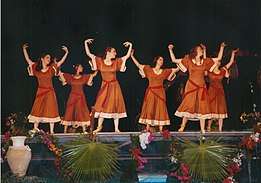Jewish dance
Jewish dance refers to dance associated with Jews and Judaism. Dance has long been used by Jews as a medium for the expression of joy and other communal emotions. Dancing was a favorite pastime and played a role in religious observance.[1]

Menorah(מְנוֹרָה) Flag of Israel Israeli music |
|---|
| Religious |
| Secular |
|
| Israel |
| Piyyutim |
| Dance |
| Music for Holidays |
|
Dances associated with Ashkenazi and Sephardi traditions, especially Jewish wedding dances, are an integral part of Jewish life in America and around the world. Folk dances associated with Zionism and the formation of the State of Israel became popular in the 1950s.[2]
Hasidic-style dance
Among Ashkenazi Jews dancing to klezmer music was an integral part of weddings in the shtetl. Jewish dance was influenced by local non-Jewish dance traditions, but there were clear differences, mainly in hand and arm motions, with more intricate legwork by the younger men.[3] The religious community frowned on mixed dancing, dictating separate circles for men and women.
In Hasidic Judaism, dance is a tool for expressing joy and is believed to have a therapeutic effect: It purifies the soul, promotes spiritual elation and unifies the community.[4]
Horah
The Horah is a Jewish circle dance typically danced to the music of Hava Nagila. It is traditionally danced at Jewish weddings and other joyous occasions in the Jewish community.[5] The hora was introduced in Israel by the Romanian Jewish dancer Baruch Agadati. In 1924, he worked together with a composer and songwriter to choreograph a show performed by the Ohel Theater Company, which toured the pioneer settlements of the Jezreel Valley. "Horah Agadati," as the dance was known, became an instant success.[6]
Yemenite step (Tza'ad Temani)
The Yemenite step (Tza'ad Temani) is a form of dancing based on hopping in place.[7] Tza'ad Temani is typical of this dance form. The Tza'ad Temani is frequently incorporated in public dancing at Jewish weddings and celebrations. The Inbal Dance Theater specializes in Yemenite dancing in Israel.[8]
Ballet
In Russia and France, the Ballets Russes was "primarily a Jewish creation," according to Paul Johnson.[9] In the United States, Jewish choreographers and dancers have been leading figures in the dance world, among them Jerome Robbins, Anna Sokolow, Michael Bennett, Michael Kidd, Ron Field, Arthur Murray, Helen Tamiris and Pearl Lang. Lincoln Kirstein was one of the founders of the School of American Ballet, The American Ballet and the New York City Ballet.
Modern dance
One of the pioneers of modern dance in Israel was Gertrud Kraus, who immigrated to Mandatory Palestine in 1935 and formed a modern dance company affiliated with the Tel-Aviv Folk Opera.[10] In 1950-1951, she founded the Israel Ballet Theatre, and became its artistic director.[10] Contemporary dance in Israel is influenced by Israeli folk dance and European traditions. Dance companies include the Kibbutz Contemporary Dance Company, Inbal Dance Theater, Bat-Dor Dance Company and Batsheva Dance Company.
Flamenco
In 2010, Silvia Duran, an Israeli flamenco dancer, was honored by King Juan Carlos I of Spain for training generations of flamenco dancers at her studio in Tel Aviv, The citation was awarded for her "contribution to the culture of Spain and the Spanish people.[11]
See also
- Culture in Israel
- Jewish music
- Secular Jewish culture
- Secular Jewish music
References
- Landa, M. J. (1926). The Jew in Drama, p. 17. New York: Ktav Publishing House (1969). Each Jewish diasporic community developed its own dance traditions for wedding celebrations and other distinguished events.
- "Jewish Dance in America". Jewish-theatre.com. 2009-02-03. Archived from the original on 2013-01-27. Retrieved 2013-02-15.
- Yiddish, Klezmer, Ashkenazic or 'shtetl' dances, Le Site Genevois de la Musique Klezmer. Accessed 12 February 2006.
- "Hasidism: Dance". Yivoencyclopedia.org. 2008-03-09. Retrieved 2013-02-15.
- "Wedding traditions". Worldweddingtraditions.com. Retrieved 2013-02-15.
- "Hora History". Forward.com. Retrieved 2013-02-15.
- "Glossary of Israeli Folk Dancing". Imber.com.au. 2009-03-19. Retrieved 2013-02-15.
- Dick Oakes (2013-02-04). "Inbal Dance Company". Google.com. Retrieved 2013-02-15.
- Johnson, op. cit., p. 410.
- "Jewish Women's Archive: Gertrud Kraus". Jwa.org. 2009-03-01. Retrieved 2013-02-15.
- "Spanish monarch honors Israeli flamenco dancer with citation". Haaretz.com. 2010-07-15. Retrieved 2013-02-15.
Further reading
- Matti Goldschmidt: The Bible in Israeli Folk Dances, Viersen 2001 (191 pages), ISBN 3-933512-12-3
External links
| Wikimedia Commons has media related to Dance of Israel. |